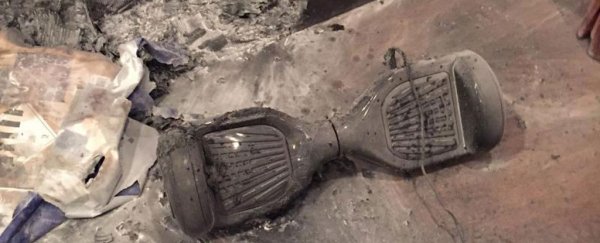Hoverboards are having a hard time of late. No sooner had these fun-looking, futuristic gizmos arrived on the scene than they've seemingly become public enemy #1 amidst a string of safety controversies.
The latest drama surrounding hoverboards – which don't actually hover, by the way, but they're the closest we can get until things like this become reality – follows a string of headline-making accidents where the devices have caught on fire.
Numerous incidents reported across the US and the UK (and presumably elsewhere) detail how hoverboards have caught alight when being charged and even when being ridden by their owners.
In one heart-breaking incident, a family in Louisiana lost their entire home after one of the boards, purchased as a gift on Amazon for their 12-year-old son, started shooting flames from both ends while the battery was being charged.
"It was like fireworks, the middle part of the board – just 'poof'," the mother of the boy told Susan Roesgen at WGNO ABC.
And even more freaky, another of the devices – also sold through Amazon, and only in use for three days – reportedly exploded under the feet of an Alabama man as he rode it outside his house.
"I came outside turned it on, came down the sidewalk not even a 100 feet [30 metres], and it exploded," Timothy Cade told Jacqueline Quynh at WKRG. "Batteries started shooting out of it; you would not expect a fire like that to come out of a little thing like that."
These repeated demonstrations that hoverboards can constitute such serious fire hazards haven't gone unnoticed. Numerous airlines have announced they will not let passengers bring hoverboards onto their planes, and Amazon has begun clamping down on the sale of the devices through its site, requiring evidence of safety compliance from hoverboard manufacturers and sellers.
But why are all these hoverboards exploding in the first place? According to Jay Whitacre, a researcher in materials science and engineering at Carnegie Mellon University, the problem doesn't lie with the hoverboards themselves, but rather the quality of the lithium-ion batteries used in the devices.
"There are a lot of factories in China that now make li-ion batteries, and the reality is that the quality and consistency of these batteries is typically not as good as what is found in top-tier producers such as LG or Samsung," Whitacre told Wired. "These are known as 'low cost li-ion batteries' by most in the industry – they are not knock-offs or copies, but are instead just mass-manufactured cells."
The fact of the matter is that cheaply made lithium-ion batteries assembled with sub-standard materials are already dangerous enough when used in things like smartphones and notebook computers – but putting them in a high-impact sport toy like a hoverboard, where they'll inevitably receive lots of jolts and bumps in their intended use scenario – might not be the smartest idea ever.
"If there is an inherent defect in the cell, it will go off at some point," said Whitacre. "Small defects in the manufacturing or materials stream lead to the plus/minus sides of the batteries being shorted with each other after a small amount of use. When this happens, especially when the batteries are charged, a lot of heat is generated inside the cells and this leads to electrolyte boiling, the rupture of the cell casing, and then a significant fire."
While the problem is exacerbated by cheaper hoverboards (which are more likely to feature cheap batteries and cheap chargers), according to Whitacre there's no guarantee that models from top-tier brands will ultimately prove safe either, as the product category is still so new that there hasn't been much real testing on the safety of hoverboards. Caveat emptor, folks!
